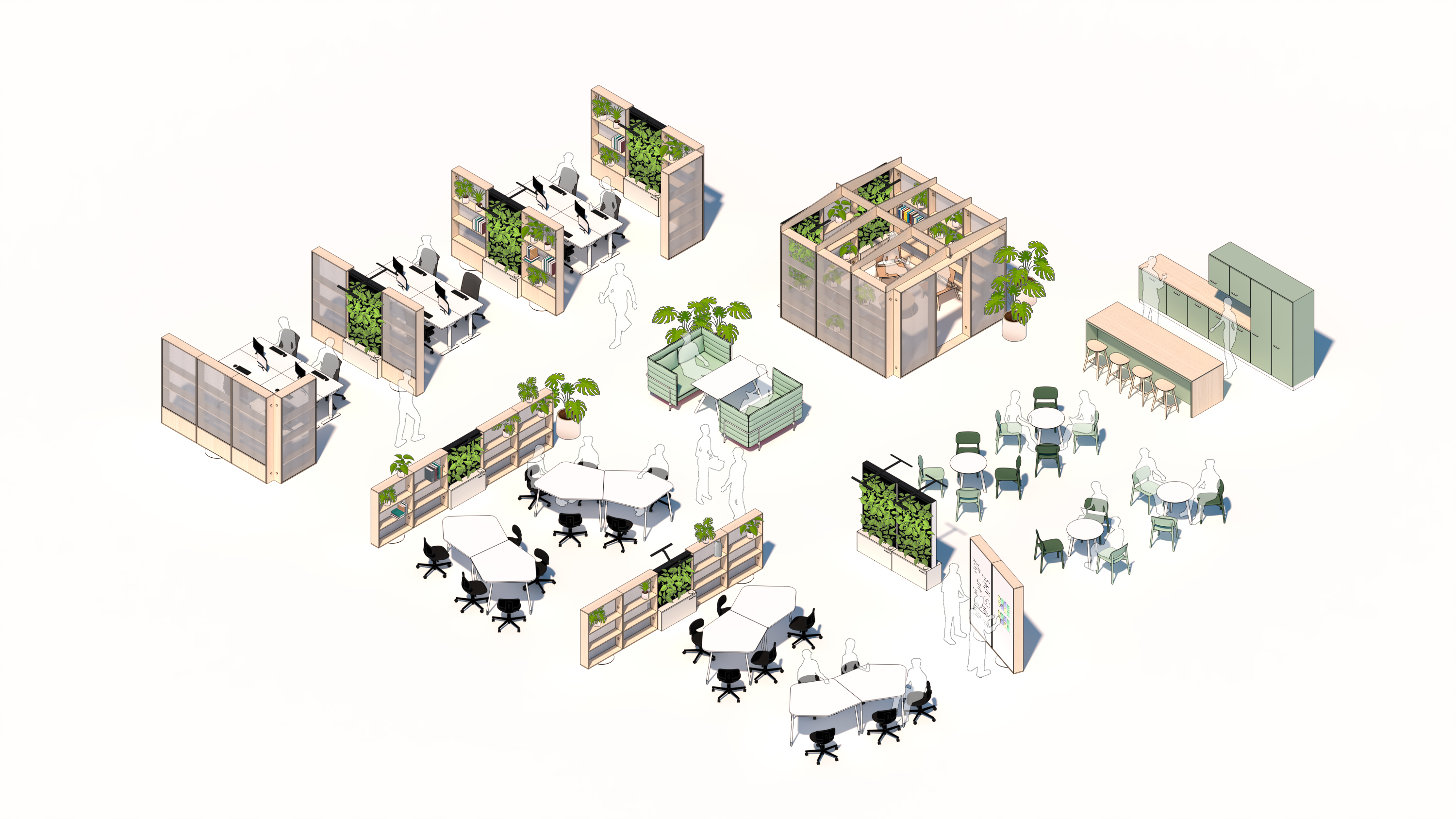As workers gradually return to the office in the midst of the ongoing COVID-19 pandemic, office managers and building owners face renewed considerations for the health and wellness impacts of office design. TPR shares this editorial from Naava CEO Aki Soudunsaari, on the value and benefits of bringing natural elements indoors through biophilic design. Naava, which designs and manufactures the Naava Green Wall, offers a fully automated solution for bringing direct nature experiences—and the inherent health benefits of biophilic design—to any office space. Find the full piece on Naava's website, here.

Aki Soudunsaari
"Biophilic design consists of three different levels of nature-connectedness: direct nature experiences (e.g. a view from a window, natural lighting, living plants), indirect nature experiences (e.g. photographs of nature, recorded nature sounds, natural shapes and colours), and the concept of space and place (e.g. does the structure of the space resemble natural spaces, does the room provide elements of shelter)"
Experiences of space and place refer to biophilic decisions that are made when designing a specific building, room, or space. These decisions might include issues such as whether the structure of the building resembles natural structures (in nature, there usually are no organized, geometrical, block-like buildings to be found) and whether the building or space incorporates elements of shelter. Fundamentally, the goal is to design solutions that resemble natural structures as much as possible, which again puts planners and designers in a responsible position.
In addition to the issues of non-geometric buildings and places of shelter, the space and place dimension also considers elements such as the predictability and complexity of a space (as nature rarely is neither predictable nor uniform) and whether the space allows for observation (the ability to observe one’s surroundings gives humans a sense of control).
Decision-makers worldwide are becoming more aware of the effects working environments have on employees and other stakeholders. Research suggests that unhealthy indoor environments can cause several problems from decreased work performance to serious illnesses.
The root cause for these indoor-related health problems is that we humans are not really designed to spend 90% of our time in indoor environments. We are actually "genetically programmed" to prefer living amongst nature. Therefore, the absence of natural elements in indoor environments is bound to make us sick.
This desire to be in contact with nature is much in conflict with the past and current state of urban planning, where the focus has mainly been on designing buildings that are as energy-efficient as possible, often without taking into account issues such as nature-connectedness and sustainability. However, due to recent research and innovation, new planning trends such as biophilic design are beginning to emerge.
Modern Urban Planning & Biophilic Design
Modern urban planners are increasingly fighting the idea of designing unhealthy, “traditional” office spaces, i.e. rows of desks and other performance-oriented office solutions. The focus of modern urban planning is, in addition to considering the energy-efficiency of buildings, progressively shifting towards incorporating more nature into indoor environments. This incorporation of nature into buildings is referred to as biophilic design.
"What is Biophilic Design?"
Biophilic design aims to create a natural indoor environment by using natural elements, materials, and shapes. Biophilic design consists of three different levels of nature-connectedness: direct nature experiences (e.g. a view from a window, natural lighting, living plants), indirect nature experiences (e.g. photographs of nature, recorded nature sounds, natural shapes and colours), and the concept of space and place (e.g. does the structure of the space resemble natural spaces, does the room provide elements of shelter). All of these ways to connect with nature have been linked to better health and well-being.
Direct Nature Experiences in Biophilic Design
Unsurprisingly, direct nature connections have the strongest impact on our health. As already mentioned, direct nature experiences can be achieved through implementing real, natural phenomena into indoor settings. Often this is done by e.g. buying potted plants or green walls, choosing an office with large windows, or having an aquarium or water fountain indoors. In addition to plants, lighting, and water, direct nature can also be brought indoors through the elements of air, fire, and animals. However, these three features are quite rarely implemented into indoor environments due to them being often fairly difficult to integrate and manage.
Potted plants in indoor settings, for example, have many healing effects on our physical and mental health. There are several studies that have compared different health variables in rooms that either have or do not have plants. The studies suggest that people in rooms with plants, when compared to rooms with no plants, experience less headaches, reduced coughing and fewer dry throats. Additionally, research states that people prefer rooms with plants in general, and report that they feel more comfortable and friendly in greener environments.
When compared to the other dimensions of biophilic design, direct nature connection is probably the easiest to understand: just get a green wall or a little water fountain for your office, or open the office curtains for more natural lighting. However, while being easy to grasp, it might simultaneously be significantly harder to implement, requiring higher levels of continuous planning and commitment.
After all, natural, living elements such as indoor plants and aquariums need regular care and maintenance and natural lighting is not always something that can easily be achieved in indoor environments. These are issues that need to be considered when designing and implementing more direct nature elements into indoor environments. Of course, if the parties involved are highly dedicated towards incorporating nature into their indoor environment and committed to the maintenance, these issues do not really pose a problem - and the effort will definitely be worth it.
Indirect Nature Experiences in Biophilic Design
Indirect nature experiences refer to e.g. the usage of natural materials, shapes, colours, and pictures in indoor settings. In other words: virtual nature - nature that can be sensed, but not as authentically as direct nature.
Research suggests that the implementation of indirect natural elements instead of direct ones does not have the same beneficial effect on our health, but nevertheless, studies do suggest that even brief, virtual nature experiences in office settings affect humans positively. Therefore, indirect nature experiences are especially important for indoor environments where real nature access would be hard to actualize. The more our modern environments include these natural elements we innately consider important, the more we will be psychologically, emotionally, and functionally supported, which again might help with e.g. coping with difficult life situations.
When compared to direct nature, indirect nature elements might be easier to implement into indoor environments as for many designers the decision to use natural materials like wood and stone might be something quite instinctive. Additionally, once successfully implemented, indirect nature elements require very little to no maintenance at all.
When Designing Indirect Nature Elements Into Indoor Spaces, Designers & Planners Hold a Lot of Responsibility
Planners and designers need to be informed about the materials, colours, and shapes they are using, and how they are using them. The natural materials, shapes, and colours need to be implemented harmoniously into a space in order to avoid feelings of disorganization and contradiction.
Nevertheless, even if the application of indirect nature elements requires active planning, it also leaves considerable space for creative thinking. Indirect nature experiences can be designed into indoor spaces in numerous ways and while the planning process behind this might be quite tedious, it can also be highly rewarding for both the designer and the client.
When compared to direct and indirect nature experiences, which can be quite flexibly designed into already existing buildings and spaces, the biophilic dimension of space and place is generally considered when designing completely new buildings. Therefore, this dimension requires, in terms of scope, significantly more effort from architects and designers than the previous two. However, excellent examples of this level of biophilic design have emerged during past years, with many more to come.
Nature is our Greatest Source of Health & Happiness
When discussing the three levels of biophilic design, it can be said that even if all of them require at least some level of careful consideration, planning, and execution, the effort will definitely be worth it. Already by simply incorporating plants or wood-made furniture into an indoor setting, it will positively influence the whole atmosphere of the environment.
Incorporating nature into urban environments is undoubtedly beneficial in many aspects. When we are surrounded by nature in our indoor environments, we are physically and mentally healthier, more productive, and more energized. In some cases, indoor nature elements have even been linked to reduced sick leaves from school and work, and shorter hospitalization times. Research has even suggested that plants and nature could lead to quicker healing after surgeries. Positive mental health effects include results such as reduced nervousness and anxiousness, lower cortisol levels, and an overall higher amount of positive emotions.
Many modern indoor spaces feature frustratingly little or no natural elements at all. Therefore, it is important to educate and remind decision-makers and designers on what biophilic design is and how positively it affects us. So that hopefully, in the future, we can all live in environments that foster our connection with nature.
5 Ways to Bring Nature Indoors to Your Home or Office
1. Use natural materials such as wood, stone, and marble when designing furniture or surfaces.
2. Buy plants, green walls, or flowers. Or grow your own plants from e.g. avocado or tomato seeds!
3. Decorate with paintings or pictures that feature natural elements.
4. Keep your curtains open as often as you can.
5. If possible, move your work desk or dining table near a window. This way you get to observe and enjoy natural phenomena like sunshine, rain, and trees that sway in the wind.
Naava Oasis—Bringing Holistic Biophilic Experiences Into Your Office
Together with Fyra, the Interior Architecture Agency of the Year 2020, and the Finnish manufacturer Maiseri, we now bring indoors not only a piece of nature - but a whole oasis.
Naava Oasis provides you with a holistic biophilic experience as it takes into consideration all three biophilic dimensions: direct nature, indirect nature, and the concept of space and place. Naava Oasis is a perfect match for open spaces - it adds diversity by providing opportunities for distancing, relaxing, and concentration.
Imagine feeling as refreshed indoors as you would do sitting underneath a tree, taking a deep breath. With Naava Oasis, you get to enjoy the stress-relieving effect of nature and the health-benefits of pure, humidified air where you most need them - indoors.
Catch a sneak peek of our Naava Oasis design below:

- Log in to post comments



